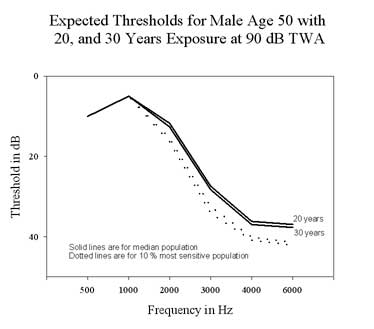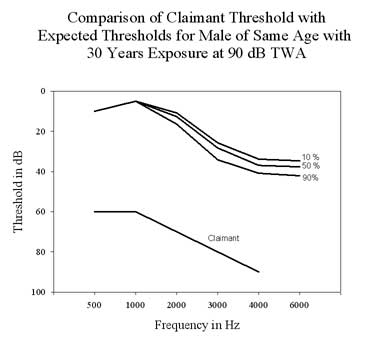Forensic Acoustics Case Study
Newspaper Plants Saved from
Fraudulent Workers’ Compensation Claims
INTRODUCTION
It wasn’t quite Murder on the Orient Express. One afternoon we received a call to investigate apparent hearing losses that had suddenly developed at two newspaper plants. It seems that there was a sudden rash of severe hearing loss in the newspaper delivery drivers.
This created concern among the lawyers processing the compensation claims for the employer. Were the noise levels to which the drivers exposed so high as to cause permanent, compensable loss of hearing? The NCAC member firm was asked to investigate and to determine employee exposures. The details of the legal complaint, which reads like a detective novel, can be found at United States District Court for the Southern District of New York [93 Civ. 7222 (LAP)]
The primary purpose of an Effective Hearing Conservation Program is to protect employee’s hearing. Of course, the first phase of an effective hearing conservation program is to document the workplace acoustical environment. But, their workers didn’t spend time in the places where high noise exposure was expected. They would arrive at work, transact some business in an office, wait near conveyors where newspapers were bundled and loaded on their trucks, and then drive throughout the metropolitan area delivering bundles of papers. An exposure survey for these employees had never been carried out since it was thought that their exposures were under 85 dB TWA.
There are other purposes for a hearing conservation program. Ostergaard Acoustical Associates has maintained that the data developed in a properly conducted hearing conservation program has at least two benefits to the employer: first, it is crucial to the protection of employee hearing and the early identification of potentially problematic noise exposures. Second, audiometry conducted by knowledgeable technicians under the supervision of a professional experienced in the evaluation of the industrial patient may serve to support the defense of claims for Occupationally Caused noise-induced hearing loss.
Forensic Acoustics Case Study – DOSE / RESPONSE
We recognize that over the past forty years rigorous, scientifically defensible dose/response relations have been established between noise exposure and the development of threshold deficits. These relationships have been widely published as International (ISO 1999 xx) and National (ANSI S3.44 xxx) Standards. These documents provide a basis on which to compare the hearing thresholds exhibited by an individual exposed to noise with the hearing thresholds of a large population of individuals similarly exposed. Furthermore, because the standards are based on a large body of data, it is possible to predict the hearing thresholds of individuals who are more and less sensitive to the effects of noise exposure.
Keep in mind, however, that the standards do not predict the thresholds of any particular noise exposed worker. They only permit comparisons between an individual and a group.
An example of the data provided in the standards is shown in the first figure. The figure shows the expected hearing threshold for a male, age 50, exposed to 90 dB TWA for 20 and 30 years. The curves shown represent the population of average susceptibility to noise and the most sensitive 10 percent of the population.

We also know, from the age adjustment tables in the OSHA Hearing Conservation Amendment, that as a population ages, its hearing, on average, becomes poorer. This suggests that if audiograms from a large group of workers of widely varying ages were compared, we should expect to find a range of hearing thresholds. It follows that if the workers were exposed to levels of noise insufficient to cause hearing loss, workers of different ages should exhibit different audiometric profiles. Any departure from these finding are cause for consternation.
Forensic Acoustics Case Study – INITIAL INVESTIGATION
INITIAL INVESTIGATION
Measurements of sound in the areas where the employees transacted their business and waited for the truck loading to be completed revealed levels in the mid- to high 70 dB(A) range. The employees spend approximately two hours at this location before leaving on deliveries.
The relatively low level of the noise exposure prompted us to ask for a sample of audiograms of the claimants for further analysis. As the noise exposures were so low, we wanted to know what thresholds were shown by some of the claimants. The attorneys provided a sample of eighty audiograms.
INSUFFICIENT NOISE LEVELS
Conparison of Hearing Threshold with Standard
The second figure shows a comparison of the threshold of an employee in this case with the thresholds predicted for the population by the standards. We found that the hearing levels claimed by the employees did not all show a typical 3KHz notch pattern for NIHL were substantially more severe than would be predicted for the measured noise exposures.

Distribution of Hearing Levels
A further discrepancy was found in the hearing thresholds themselves. The employees ranged in age from 26 years to over 70 years old. All the hearing thresholds however, fell within approximately 10 dB of one another. For this range of ages, considering different sensitivities of individuals to noise and different rates of development of presbycusis, a range of 40 dB would be more typical.
Forensic Acoustics Case Study – Miraculous Recoveries
These findings were very suspicious. As a result, the attorneys investigated further by having several of the claimants reexamined by an audiologist who was experienced in dealing with evaluation of claimants for compensation of NIHL. They also found that the drivers had recently undergone medical tests to re-qualify for their commercial drivers licenses – tests that included audiometric testing. All had passed the medical tests.
“In many cases, after comparing the results of the audiogram with the results of the tests referred to above, and noting they were not consistent, [the audiologist] then informed the claimants of the inconsistency and explained to them that the claimant’s initial audiogram could not be accurate. In a number of cases, the claimants then responded accurately during a subsequent audiogram … the results of which revealed that those claimants do not have a binaural loss of hearing.”
THE FINAL RESULT
One test case was brought before a Worker Compensation Board Administrative Law Judge for adjudication. After many hours of testimony the judge dismissed not only the test case, he also dismissed the remaining claims finding them fraudulent. The legal team had uncovered numerous irregularities in the claims. The employer filed a civil action against the employees, their attorneys, and the physician who examined them under the Racketeering In Corrupt Organizations (RICO) laws.
Under the RICO Act, a successful plaintiff may recover treble damages which is the relief sought in this action. “Plaintiffs have suffered damages to date to be determined but believed to exceed $3 millions a direct and proximate result of the defendants’ unlawful conduct.”
